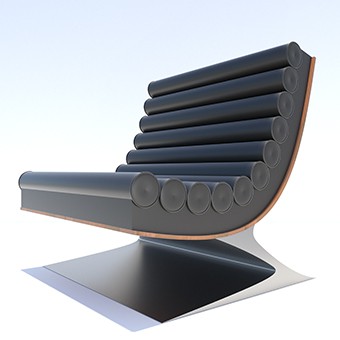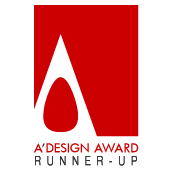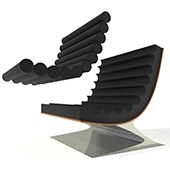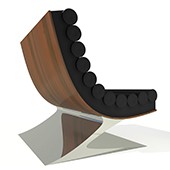Zattera Lounge Chair by B. David Levine |
Home > |
 |
|
||||
| DESIGN DETAILS | |||||
| DESIGN NAME: Zattera PRIMARY FUNCTION: Lounge Chair INSPIRATION: As I randomly sketched shapes and forms, I fixated on a row of cord or cylinders which reminded me of corduroy fabric or a log raft. The possibilities of varying each cylinder round with different colors or fabric or firmness intrigued me. I formed these shapes into different contours that could become a chair. Like corduroy, the chair would be a repetitive surface of upholstered cylinder channels, which could be varied, or could be identical, adjusting to one's contour as desired. By attaching the channels with Velcro, the individual rows could be easily replaced. Each channel could have its own feel and purpose. It's a modern concept which can be changed and recreated as desired. UNIQUE PROPERTIES / PROJECT DESCRIPTION: The upholstery cushion is a system of eleven independent tubes linked together, resting in a cradle of upholstered precast high density foam, attached to a molded plywood shell. The independent units are attached to each other with a Velcro strip, making it possible to change any of them for cylinders of different degrees of firmness as desired for individual comfort, a different fabric, a different design look or to replace them if damaged. The aluminum base can have embedded LED strip lights and can house a concealed battery unit or USB outlet or power outlet, and function as source lighting, night lighting, or dramatic lighting in a room. The chair will work equally well in a residential or commercial space. The design can be ganged together to create a long sitting area. OPERATION / FLOW / INTERACTION: Cushions can come off and be changed with other cushions of varying firmnesses. If a part is damaged it can be replaced and new themes and colors can be introduced. PROJECT DURATION AND LOCATION: The project began in Los Angeles, California, USA, as a concept in March of 2015. Initial drawings and models were developed during the next eleven months. It was then put aside for a couple of months, then we revisited the project, made some alterations and began to research and select materials that would be appropriate to produce the chair with. In May of 2017, we made a computer generated model. We conducted some market testing and decided the design was complete in June of that year also in Los Angeles, California, USA. FITS BEST INTO CATEGORY: Furniture Design |
PRODUCTION / REALIZATION TECHNOLOGY: Molded 1/2" thick walnut plywood shell, applied to an extruded aluminum sculptural base. Concealed LED lights in base and a molded foam upholstered unit, applied to the walnut shell. The upholstery shell supports eleven individual cushion cylinders. The fill for the cylinders can vary between feather and down or feather and down wrapped foam core or marshal unit. Or the pillow inserts can be various degrees of firm high density foam. The fabrics for the chair can be leather, faux leather or fabric. Cylinders are edged with a 6.35 mm pipe welt. Upholstery stitching is with a fine double saddle stitch. SPECIFICATIONS / TECHNICAL PROPERTIES: Width: 965 mm x Depth: 977 mm x Height: 1009 mm Seat Height: 469 mm. It tappers to the back on an angle of 6.5 degrees over a span of 495 mm. Seat back is 584 mm high from the seat with a 20 degree pitch. The cushions are 101 mm. They seat on a 76 mm foam. TAGS: contract seating, residential seating, lounge seating, upholstered bend wood seating, upholstered chair, customizable, reconfigurable, seating with integrated lighting, sculptural seating RESEARCH ABSTRACT: Ergonomics to make the chair comfortable to the majority of people in a relaxed position, yet still leaving the person upright enough for general conversation. We did it by studying how the body fits into furniture, by having people seat in different situations and making a model of the proportions of the chair and having people seat on it. Then we recorded our results, studied them. We made cylindrical cushions with different combinations of fillings and tried them to see how bodies would react to the combinations of fills and proportions of the chair. We looked into the lighting to see the most appropriate ways to power the lighting of the chair. CHALLENGE: It was a challenge to keep the base looking sculptural and proportionate to the upper part of the chair, and still support the displaced weight of the molded shell and filled rolls with the person sitting in the chair. It was also a challenge to conceal the power source for the lighting as required. ADDED DATE: 2018-02-24 03:40:08 TEAM MEMBERS (1) : IMAGE CREDITS: B. David Levine, 2017. PATENTS/COPYRIGHTS: Copyrights belong to B. David Levine, 2015 |
||||
| Visit the following page to learn more: http://www.bdavidlevine.com | |||||
| AWARD DETAILS | |
 |
Zattera Lounge Chair by B. David Levine is Runner-up for A' Design Award in Furniture Design Category, 2017 - 2018.· Read the interview with designer B. David Levine for design Zattera here.· Press Members: Login or Register to request an exclusive interview with B. David Levine. · Click here to register inorder to view the profile and other works by B. David Levine. |
| SOCIAL |
| + Add to Likes / Favorites | Send to My Email | Comment | Testimonials |








